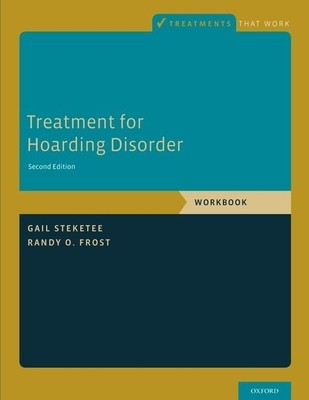
- We will send in 10–14 business days.
- Author: Gail Steketee
- Publisher: Oxford University Press, USA
- ISBN-10: 0199334943
- ISBN-13: 9780199334940
- Format: 21.3 x 27.7 x 1.5 cm, minkšti viršeliai
- Language: English
- SAVE -10% with code: EXTRA
Reviews
Description
The relationship people have with their possessions ranges from purely utilitarian to intensely emotional. For most people, their personal possessions provide them with a sense of security, comfort, and pleasure. However, if someone loses the ability to distinguish useful or important possessions from those that make life overly complicated, the objects can become a prison. For people who suffer from Hoarding Disorder (HD), the process of getting rid of unneeded objects is not easy. For them, possessions never "feel" unneeded and trying to get rid of them is an excruciating emotional ordeal.
This Second Edition of Treatment for Hoarding Disorder is the culmination of more than 20 years of research on understanding hoarding and building an effective intervention to address its myriad components. Thoroughly updated and reflective of changes made to the Fifth Edition of the Diagnostic and Statistical Manual for Mental Disorders (DSM-5), this second edition of the client Workbook and accompanying Therapist Guide outlines an empirically supported and effective CBT program for treating hoarding disorder. This Workbook is meant to guide clients through their treatment for hoarding disorder with their clinician. It includes homework, forms, exercises, and behavioral experiments for clients to test their personal beliefs about possessions, develop an organization plan and filing system, and sort and organize items room by room. A major goal of the treatment is to recapture the positive role of possessions in the lives of people with hoarding problems, and strategies are outlinedfor sustaining gains and making further progress, as well as for managing stressful life events that can provoke problematic acquiring and difficulty discarding.
EXTRA 10 % discount with code: EXTRA
The promotion ends in 21d.16:55:32
The discount code is valid when purchasing from 10 €. Discounts do not stack.
- Author: Gail Steketee
- Publisher: Oxford University Press, USA
- ISBN-10: 0199334943
- ISBN-13: 9780199334940
- Format: 21.3 x 27.7 x 1.5 cm, minkšti viršeliai
- Language: English English
The relationship people have with their possessions ranges from purely utilitarian to intensely emotional. For most people, their personal possessions provide them with a sense of security, comfort, and pleasure. However, if someone loses the ability to distinguish useful or important possessions from those that make life overly complicated, the objects can become a prison. For people who suffer from Hoarding Disorder (HD), the process of getting rid of unneeded objects is not easy. For them, possessions never "feel" unneeded and trying to get rid of them is an excruciating emotional ordeal.
This Second Edition of Treatment for Hoarding Disorder is the culmination of more than 20 years of research on understanding hoarding and building an effective intervention to address its myriad components. Thoroughly updated and reflective of changes made to the Fifth Edition of the Diagnostic and Statistical Manual for Mental Disorders (DSM-5), this second edition of the client Workbook and accompanying Therapist Guide outlines an empirically supported and effective CBT program for treating hoarding disorder. This Workbook is meant to guide clients through their treatment for hoarding disorder with their clinician. It includes homework, forms, exercises, and behavioral experiments for clients to test their personal beliefs about possessions, develop an organization plan and filing system, and sort and organize items room by room. A major goal of the treatment is to recapture the positive role of possessions in the lives of people with hoarding problems, and strategies are outlinedfor sustaining gains and making further progress, as well as for managing stressful life events that can provoke problematic acquiring and difficulty discarding.


Reviews